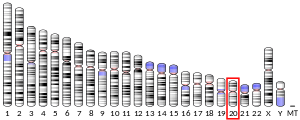KIZ (gene)
Kizuna centrosomal protein is a protein that in humans is encoded by the KIZ gene.[5]
| KIZ | |||||||||||||||||||||||||
|---|---|---|---|---|---|---|---|---|---|---|---|---|---|---|---|---|---|---|---|---|---|---|---|---|---|
| Identifiers | |||||||||||||||||||||||||
| Aliases | KIZ, C20orf19, Kizuna, NCRNA00153, PLK1S1, RP69, HT013, kizuna centrosomal protein | ||||||||||||||||||||||||
| External IDs | OMIM: 615757 MGI: 2684960 HomoloGene: 10219 GeneCards: KIZ | ||||||||||||||||||||||||
| |||||||||||||||||||||||||
| |||||||||||||||||||||||||
| |||||||||||||||||||||||||
| Orthologs | |||||||||||||||||||||||||
| Species | Human | Mouse | |||||||||||||||||||||||
| Entrez | |||||||||||||||||||||||||
| Ensembl | |||||||||||||||||||||||||
| UniProt | |||||||||||||||||||||||||
| RefSeq (mRNA) |
| ||||||||||||||||||||||||
| RefSeq (protein) |
| ||||||||||||||||||||||||
| Location (UCSC) | Chr 20: 21.13 – 21.25 Mb | Chr 2: 146.86 – 146.97 Mb | |||||||||||||||||||||||
| PubMed search | [3] | [4] | |||||||||||||||||||||||
| Wikidata | |||||||||||||||||||||||||
| |||||||||||||||||||||||||
Function
The protein encoded by this gene localizes to centrosomes, strengthening and stabilizing the pericentriolar region prior to spindle formation. The encoded protein usually remains with the mother centrosome after centrosomal duplication. Several transcript variants encoding different isoforms have been found for this gene. [provided by RefSeq, Feb 2013].
Clinical significance
Mutations in KIZ cause Rod-cone dystrophy (RCD).[6]
References
- GRCh38: Ensembl release 89: ENSG00000088970 - Ensembl, May 2017
- GRCm38: Ensembl release 89: ENSMUSG00000074749 - Ensembl, May 2017
- "Human PubMed Reference:". National Center for Biotechnology Information, U.S. National Library of Medicine.
- "Mouse PubMed Reference:". National Center for Biotechnology Information, U.S. National Library of Medicine.
- "Entrez Gene: Kizuna centrosomal protein".
- El Shamieh S, Neuillé M, Terray A, Orhan E, Condroyer C, Démontant V, Michiels C, Antonio A, Boyard F, Lancelot ME, Letexier M, Saraiva JP, Léveillard T, Mohand-Saïd S, Goureau O, Sahel JA, Zeitz C, Audo I (2014). "Whole-Exome Sequencing Identifies KIZ as a Ciliary Gene Associated with Autosomal-Recessive Rod-Cone Dystrophy". Am. J. Hum. Genet. 94 (4): 625–33. doi:10.1016/j.ajhg.2014.03.005. PMC 3980423. PMID 24680887.
Further reading
- Oshimori N, Li X, Ohsugi M, Yamamoto T (2009). "Cep72 regulates the localization of key centrosomal proteins and proper bipolar spindle formation". EMBO J. 28 (14): 2066–76. doi:10.1038/emboj.2009.161. PMC 2718283. PMID 19536135.
- Oshimori N, Ohsugi M, Yamamoto T (2006). "The Plk1 target Kizuna stabilizes mitotic centrosomes to ensure spindle bipolarity". Nat. Cell Biol. 8 (10): 1095–101. doi:10.1038/ncb1474. PMID 16980960.
This article incorporates text from the United States National Library of Medicine, which is in the public domain.
This article is issued from Wikipedia. The text is licensed under Creative Commons - Attribution - Sharealike. Additional terms may apply for the media files.



